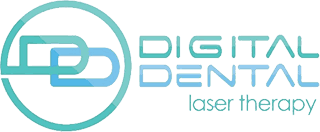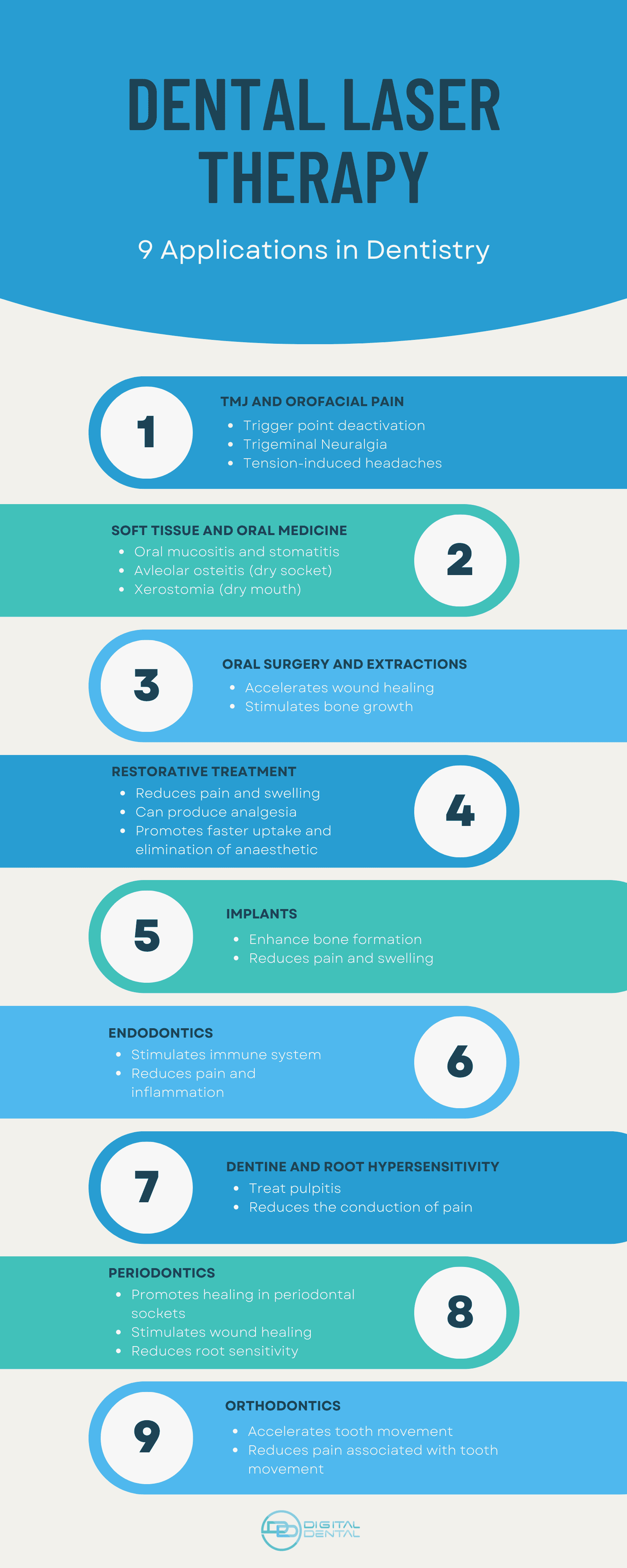Let’s face it: according to the International Dental Journal, almost 90% of Australians live within a 5km radius of a dental practice. So how do you make your practice the one that stands out? The secret is by incorporating dental laser therapy into your practitioner’s clinical routine. Read on to learn what laser therapy is, 5 reasons why laser therapy will give your practice a competitive edge in the dental market, and which dental laser is the best one to use.
What is Laser Therapy, and How Does It Work?
Laser therapy covers any use of LED and NIR (near-infrared light), used to stimulate healing. Also known as photobiomodulation (PBMT), it’s a type of treatment that uses focused light energy to stimulate cellular activity in the body. It uses light energy to elicit biological responses from cells and to normalise their function by stimulating the mitochondria, which are often referred to as the powerhouses of the cell. This, in turn, generates adenosine triphosphate (ATP), which is the primary energy source for most biochemical and physiological processes, such as growth, movement and homeostasis.
In a dental practice, photobiomodulation can be applied to a variety of dental conditions, including tooth decay, gum disease, and oral infections. The light energy from the laser is absorbed by cells in the affected area, which stimulates the production of new cells and promotes the healing of damaged tissue. Photobiomodulation is generally considered to be a safe and effective treatment option, and it reduces the amount of discomfort and downtime associated with certain dental procedures.
According to Professor Laurence J. Walsh, this technology has been around for over 50 years in modern medical, physiotherapy and veterinary practice. It’s been used to reduce pain and inflammation, and to accelerate healing, so it has great potential for clinical applications in dentistry.
Key Reasons to use MLS® laser in your practice
The top 5 reasons below will elaborate on MLS® laser’s benefits for dental practices, dentists, and patients.
- Enhance Clinical Outcomes
- Give patients a pain-free dental experience
- Fast, effective, and long-lasting treatments
- Provide an additional income stream
- Become an industry leader in dental technology
1. Enhance Clinical Outcomes
Dental laser therapy can help dentists enhance clinical outcomes in virtually all aspects of dentistry!
The laser reduces pain, so it can be used before and after dental treatment and for treating TMJ, orofacial pain, and trigger points. It also reduces inflammation and speeds up healing, which is ideal for extractions, implants, periodontics, and orthodontics. In orthodontics, studies have shown that PBMT can accelerate tooth movement, reducing the time required to straighten teeth! Moreover, it can be used in oral medicine to reduce pain for oral mucositis, trigeminal neuralgia, oral lichen planus, xerostomia (dry mouth) and recurrent herpes simplex infections.
By enhancing clinical outcomes using PBMT, dentists gain greater satisfaction and a higher success rate from treatment outcomes. In addition, patients can see the results of their treatment faster. It’s a win-win for everyone!
2. Give patients a pain-free dental experience
Therapeutic dental lasers are non-invasive and painless. MLS® laser is a great tool for those who have dental anxiety or hate the dentist because of the pain that results from various treatments. It also reduces the need for needles, and we all know that patients would prefer not to have an injection!
Dental laser therapy has the potential to change a patient’s perception of the dentist by viewing it as a pain-free experience. It can attract new patients and retain existing clients. In addition, patients may refer their friends and family because of the good experience they’ve had with the therapeutic dental laser.
3. Fast, effective, and long-lasting treatment
With photobiomodulation, you only need to treat the area for a couple of minutes at a time, so it can be incorporated into a clinical routine without prolonging the total treatment time excessively. In addition, it treats pain, inflammation, and oedema at the cellular level – the source of the pain. After a course of laser therapy is completed, patients rarely need to return for repeat treatment.
This is a great way for you to enhance clinical outcomes and provide patients with quality dental treatment. It also gives you the ability to treat pain quickly and effectively as well as accelerate the healing process.
4. Provides an additional income stream
Dental laser therapy, gives you the ability to expand your scope of practice, providing an additional income stream. For example, you can treat patients with oral pathologies, TMJ issues, and orofacial pain as mentioned above. So instead of being a general dentist who usually refers these cases to specialists, you can treat a wide variety of dental and orofacial conditions in your own practice.
This helps your dental practice stand out from others in your area by offering a variety of services to patients. It also allows patients to receive treatment at one practice rather than being referred to specialists. All of this means that your practice can increase its total income.
5. Become an industry leader in dental technology
Photobiomodulation is an area of growing interest in the dental community. There is considerable research to support its use to treat a variety of dental conditions. What’s more, it’s safe and pain-free.
This is a prime opportunity to set yourself apart from other dental practices by incorporating laser therapy into your clinical routine. Your dentists will be regarded as industry experts and as leaders in dental innovation, not just by their peers, but also by patients and the general community.
What’s the best dedicated therapeutic dental laser?
MLS® dental lasers are the only therapeutic lasers with built in dental protocols. They are produced by ASA Laser, which is an Italian company that designs and produces high quality class 4 lasers. ASA developed a unique patented multi-wave locked laser system (MLS®) that provides maximum impact on pain, inflammation, and oedema.
The MLSׅ® system combines two different wavelengths that are synchronised together. One is a 905nm pulsed emission, which has an analgesic effect, reducing pain for the patient. The other is the 808nm continuous emission, which effectively reduces swelling and inflammation and, speeds up tissue repair. Clinical trials have proven these wavelengths are more effective when applied together than separately, amplifying the results for patients. This laser penetrates 3-4cm deep into damaged tissue on a cellular level, so it’s effective at treating the source of the pain.
With this laser and its advanced technology, you can take your practice to the next level. This investment will enhance your dentist’s clinical outcomes while providing high quality care for your patients. If you’re interested in learning more, watch the video below to see how dental practitioners have benefitted from using the MLS® dental laser, or click the button at the bottom of the article to book a demo of our therapeutic dental laser.
MLS® dental lasers are an excellent asset to help your dental practice stand out from your competition. It enhances clinical outcomes and provides patients with fast, effective, and long-lasting treatment as well as a pain-free dental experience. It’s a great way to increase revenue for your practice and to help your team be seen as leaders in dental innovation.
If you’re interested in incorporating laser therapy into your dental practice, MLS® dental lasers are the best available on the market. They effectively reduce pain, inflammation, and oedema at a cellular level. Book a demo below to see how it can help you stand out from the crowd.


